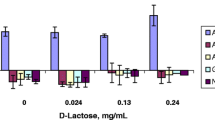Abstract
This study was undertaken to categorize representative fluoroquinolone drug substance permeability based on the methods outlined in the Food and Drug Administration's biopharmaceutic classification system (BCS) Guidance for Industry. The permeability of ciprofloxacin, levofloxacin, lomefloxacin, and ofloxacin was measured in an in vitro Caco-2 assay with previously demonstrated method suitability. The permeability class and efflux potential were ascertained by comparing test drug results with standard compounds (metoprolol, atenolol, labetalol, and rhodamine-123). All 4 quinolones drugs demonstrated concentration-dependent permeability, indicating active drug transport. In comparing absorptive versus secretive in vitro transport, the tested fluoroquinolones were found to be subject to efflux in varying degrees (ciprofloxacin > lomefloxacin > rhodamine 123 > levofloxacin > ofloxacin). Based on comparison to labetalol, the high permeability internal standard, ciprofloxacin was classified as a low permeability drug, whereas lomefloxacin, levofloxacin, and ofloxacin were classified as high permeability drugs. The in vitro permeability results matched human in vivo data based on absolute bioavailabilities. This laboratory exercise demonstrated the applicability of an in vitro permeability method for classifying drugs as outlined in the BCS Guidance.
Similar content being viewed by others
References
Amidon GL, Lennernas H, Shah VP, Crison JR. A theoretical basis for a biopharmaceutic drug classification: the correlation of in vitro drug product dissolution and in vivo bioavailability. Pharm Res. 1995;12:413–420.
Center for Drug Evaluation and Research. Food and Drug Administration. Guidance for Industry: Waiver of In Vivo Bioavailability and Bioequivalence Studies for Immediate-Release Solid Oral Dosage Forms Based on a Biopharmaceutics Classification System. Available at: http://www.fda.gov/cder/guidance/3618fnl.pdf. Accessed August 2000.
Volpe DA, Ciavarella AB, Asafu-Adjaye EB, Ellison CD, Faustino PJ, Yu LX. Method suitability of a Caco-2 cell model for drug permeability classification [abstract]. AAPS Pharm Sci. 2001; 3(S 1). Available at: http://www.aapspharmaceutica.com/search/abstract_view. asp?id=385&ct=01Abstracts.
Owens RC, Ambrose PG. Clinical use of the fluoroquinolones. Med Clin North Am. 2000;84:1447–1469.
Hooper DC. Mode of action of fluoroquinolones. Drugs. 1999;58(suppl 2):6–10.
Pickerill KE, Paladino JA, Schentag JJ. Comparison of the fluoroquinolones based on pharmacokinetic and pharmacodynamic parameters. Pharmacotherapy. 2000;20:417–428.
Lode H, Hoffken G, Boeckk M, Deppermann N, Bomer K, Koeppe P. Quinolone pharmacokinetics and metabolism. J Antimicrob Chemother. 1990;26(suppl B):41–49.
Cipro® (ciprofloxacin hydrochloride tablets) [product information]. West Haven, CT: Bayer Corporation; 2000.
Levaquin® (levofloxacin tablets/injection) [product information]. Raritan, NJ: Ortho-McNeil Pharmaceutical, Inc; 2000.
Maxaquin® (lomefloxacin hydrochloride tablets) [product information]. Buffalo Grove, IL: Unimed Pharmaceuticals; 1999.
Floxin® (ofloxacin tablets) [product information]. Raritan, NJ: Ortho-McNeil Pharmaceutical Inc; 1998.
Bergan T. Pharmacokinetics of fluorinated quinolones. In: Andriole VT, ed. The Quinolones. London, UK: Academic Press; 1988: 119–152.
Cavet ME, West M, Simmons NL. Fluoroquinolone (ciprofloxacin) secretion by human intestinal epithelial (Caco-2) cells. Br J Pharmacol. 1997;121:1567–1578.
Griffiths NM, Hirst BH, Simmons NL. Active intestinal secretion of the fluoroquinolone antibacterials ciprofloxacin, norfloxacin and pefloxacin; a common secretory pathway? J Pharmacol Exp Ther. 1994;269:496–502.
Griffiths NM, Hirst BH, Simmons NL. Active secretion of the fluoroquinolone ciprofloxacin by human intestinal epithelial Caco-2 cell layers. Br J Pharmacol. 1993;108:575–576.
Yamaguchi H, Yano I, Saito H, Inui K. Transport characteristics of grepafloxacin and levofloxacin in the human intestinal cell line Caco-2. Eur J Pharmacol. 2001;431:297–303.
Yamaguchi H, Yano I, Hashimoto Y, Inui KI. Secretory mechanisms of grepafloxacin and levofloxacin in the human intestinal cell line Caco-2. J Pharmacol Exp Ther. 2000;295:360–366.
Awadallah B, Wahl MA. Transport of ofloxacin enantiomers in the Caco-2-TC7 cell line [abstract]. AAPS Pharm Sci. 2002; 4(S1). Abstract W5049. Available at: http://www.aapspharmsci.org.
Rodriguez-Ibáñez M, Nalda-Molina R, Montala-Montero M, Bermejo MV, Merino V, Garrigues TM. Transintestinal secretion of ciprofloxacin, grepafloxacin and sparafloxacin: in vitro and in situ inhibition studies. Eur J Pharm Biopharm. 2003;55:241–246.
Author information
Authors and Affiliations
Corresponding author
Additional information
Published: April 5, 2004
Rights and permissions
About this article
Cite this article
Volpe, D.A. Permeability classification of representative fluoroquinolones by a cell culture method. AAPS J 6, 13 (2004). https://doi.org/10.1208/ps060213
Received:
Accepted:
Published:
DOI: https://doi.org/10.1208/ps060213




